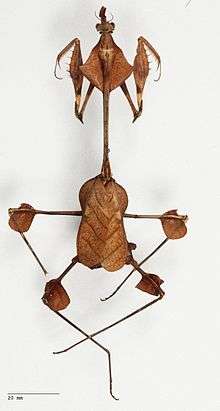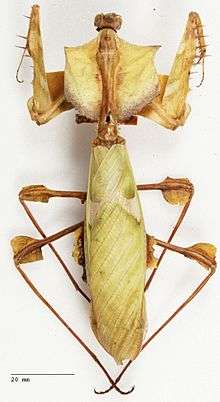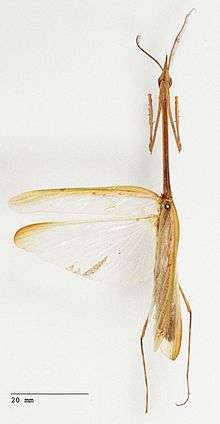Empusidae
Empusidae is a family of plant-mimicking mantids[1] (see Mantodea), consisting of 10 genera, holding almost 30 species.[2] Unlike many other mantid families, the Empusidae are a monophyletic lineage.[1][3][4] Empusidae mantids are ambush predators,[4] with mouthparts adapted to feeding on other insects and small animals.[3] The majority of Empusidae species are distributed throughout Africa, but they are also found in Southeast Asia and in the southern parts of Europe.[5]
| Empusidae | |
|---|---|
 | |
| Empusa pennata | |
| Scientific classification | |
| Kingdom: | Animalia |
| Phylum: | Arthropoda |
| Class: | Insecta |
| Order: | Mantodea |
| Family: | Empusidae |
| Genera | |
| |
Natural history
The Empusidae species Gongylus gongylodes (Linné, 1758)[1] was the first mantid species ever to be described. Since Gongylus mantids have been fascinating entomologists and have been bred in captivity for a long time, their behavior and breeding preferences are well known, such as a defensive behavior of displaying a hissing noise by rubbing the anterior edges of its serrated fore wings to the femur of the hind legs.[1]
Morphology
The about 28 species of empusid mantids[2] are all relatively large and bizarre looking. The prothorax is always surrounded by a crest and the femur of the middle and hind legs often have flap-like appendages. The pronotum is characteristically elongated and the abdomen is often lobed.[5] Members of the Mantoidea superfamily possess a cyclopean ear, an organ situated on the metathorax, which has been proven to be an adaptation to bat predation. The presence of this adaptation has been dated to originate in the early Eocene.[6]
Phylogeny
The Empusidae belong to the superfamily Mantoidea, (“higher” mantises), together with the Mantidae and Hymenopodidae.[6] Phylogenetic studies place the Empusidae as a sister group to the Hymenopodidae. The Empusidae and Hymenopodidae are, in turn, placed as sister groups to all other ambush mantids.[4] [3]. Two subfamilies are placed within the Empusidae, Blepharodinae, and Empusinae. The Blepharodinae subfamily holds three genera, Blepharodes, Blepharopsis and Idolomantis. The Empusinae subfamily is divided into two tribes, the Empusini and Idolomorphini. The Empusini tribe holds five genera, Dilatempusa, Empusa, Gonglyus, and Hypsicorypha. The Idolomorphini tribe holds the three remaining genera, Hemiempusa, Idolomorpha, and Chopardempusa.[2] The latest phylogeny was revised by Svenson et al. 2015.[1]
Images



See also
References
- Svenson, Gavin J., et al. "Of flowers and twigs: phylogenetic revision of the plant‐mimicking praying mantises (Mantodea: Empusidae and Hymenopodidae) with a new suprageneric classification." Systematic Entomology 40.4 (2015)
- Mantodea Species File, 2017. http://mantodea.speciesfile.org/Common/basic/Taxa.aspx?TaxonNameID=1182268 Retrieved 11 January 2017.
- Khokhar, Jawaid A., and N. M. Soomro. "A Comparative Study of Structural Adaptations of Mouthparts in Mantodea From Sindh." Pakistan J. Zool 41.1 (2009): 21-27.
- Svenson, Gavin J., and Michael F. Whiting. "Phylogeny of Mantodea based on molecular data: evolution of a charismatic predator." Systematic Entomology 29.3 (2004): 359-370.
- Ehrmann, Reinhard. Mantodea Gottesanbeterinnen der Welt. Natur und Tier, 2002.
- Grimaldi, David and Michael S. Engel. Evolution of the Insects. Cambridge University Press, 2005.